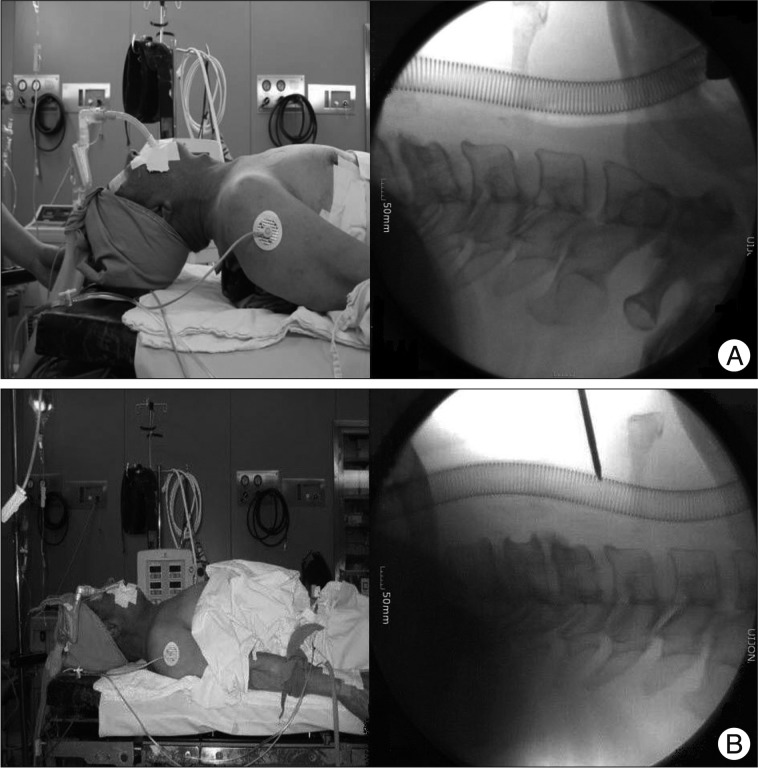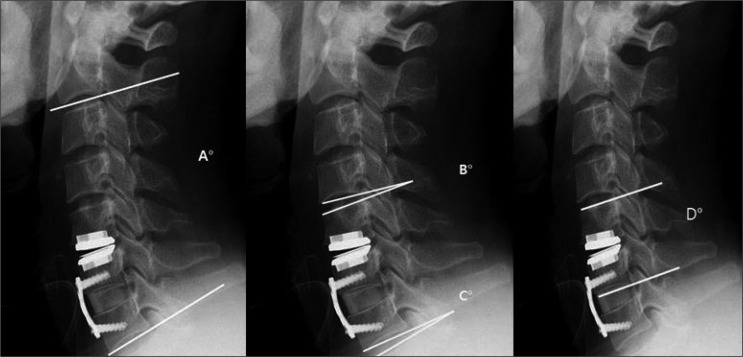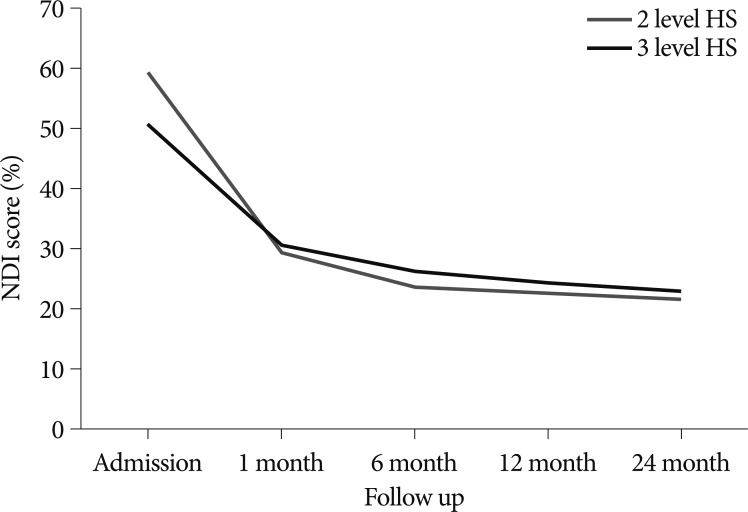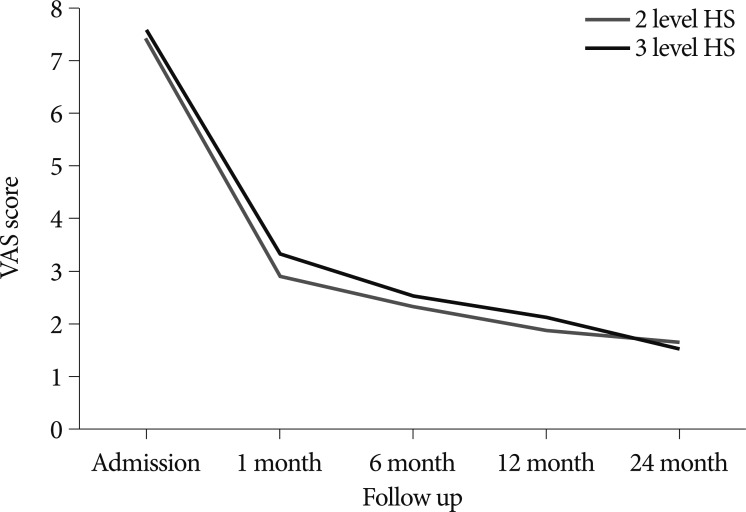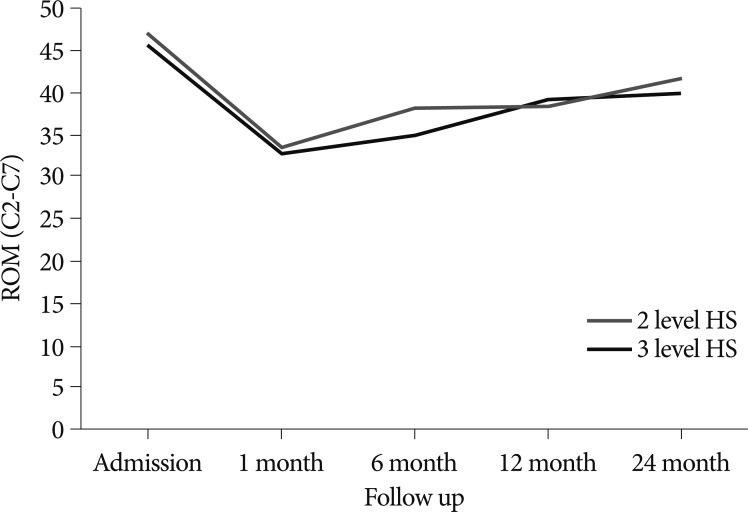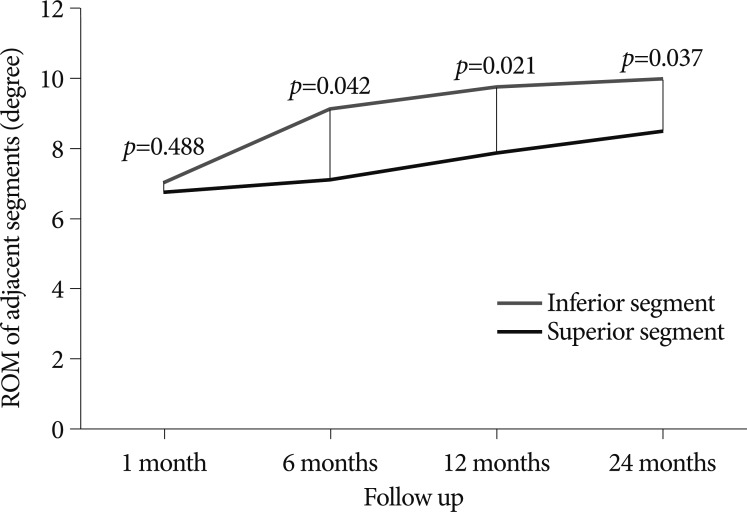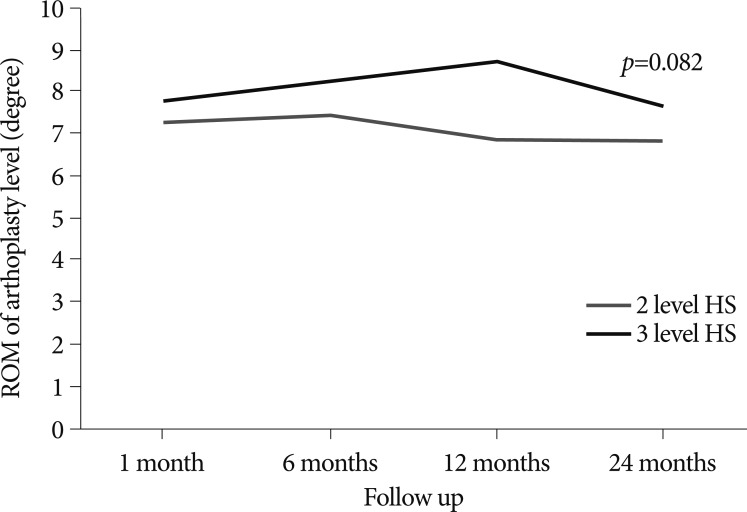J Korean Neurosurg Soc.
2012 Nov;52(5):452-458. 10.3340/jkns.2012.52.5.452.
Hybrid Surgery of Multilevel Cervical Degenerative Disc Disease : Review of Literature and Clinical Results
- Affiliations
-
- 1Department of Neurosurgery, Uijeongbu St. Mary's Hospital, The Catholic University of Korea School of Medicine, Uijeongbu, Korea. leesb@catholic.ac.kr
- KMID: 2018251
- DOI: http://doi.org/10.3340/jkns.2012.52.5.452
Abstract
OBJECTIVE
In the present study, we evaluated the effect, safety and radiological outcomes of cervical hybrid surgery (cervical disc prosthesis replacement at one level, and interbody fusion at the other level) on the multilevel cervical degenerative disc disease (DDD).
METHODS
Fifty-one patients (mean age 46.7 years) with symptomatic multilevel cervical spondylosis were treated using hybrid surgery (HS). Clinical [neck disability index (NDI) and Visual Analogue Scale (VAS) score] and radiologic outcomes [range of motion (ROM) for cervical spine, adjacent segment and arthroplasty level] were evaluated at routine postoperative intervals of 1, 6, 12, 24 months. Review of other similar studies that examined the HS in multilevel cervical DDD was performed.
RESULTS
Out of 51 patients, 41 patients received 2 level hybrid surgery and 10 patients received 3 level hybrid surgery. The NDI and VAS score were significantly decreased during the follow up periods (p<0.05). The cervical ROM was recovered at 6 and 12 month postoperatively and the mean ROM of inferior adjacent segment was significantly larger than that of superior adjacent segments after surgery. The ROM of the arthoplasty level was preserved well during the follow up periods. No surgical and device related complications were observed.
CONCLUSION
Hybrid surgery is a safe and effective alternative to fusion for the management of multilevel cervical spondylosis.
Keyword
MeSH Terms
Figure
Reference
-
1. Baba H, Furusawa N, Imura S, Kawahara N, Tsuchiya H, Tomita K. Late radiographic findings after anterior cervical fusion for spondylotic myeloradiculopathy. Spine (Phila Pa 1976). 1993; 18:2167–2173. PMID: 8278827.
Article2. Barbagallo GM, Assietti R, Corbino L, Olindo G, Foti PV, Russo V, et al. Early results and review of the literature of a novel hybrid surgical technique combining cervical arthrodesis and disc arthroplasty for treating multilevel degenerative disc disease: opposite or complementary techniques? Eur Spine J. 2009; 18(Suppl 1):29–39. PMID: 19415346.
Article3. Bertagnoli R, Yue JJ, Pfeiffer F, Fenk-Mayer A, Lawrence JP, Kershaw T, et al. Early results after ProDisc-C cervical disc replacement. J Neurosurg Spine. 2005; 2:403–410. PMID: 15871478.
Article4. Bryan VE Jr. Cervical motion segment replacement. Eur Spine J. 2002; 11(Suppl 2):S92–S97. PMID: 12384728.
Article5. Cardoso MJ, Rosner MK. Multilevel cervical arthroplasty with artificial disc replacement. Neurosurg Focus. 2010; 28:E19. PMID: 20568935.
Article6. Cherry C. Anterior cervical discectomy and fusion for cervical disc disease. AORN J. 2002; 76:998–1004. 1007–1008. quiz 1009-1012. PMID: 12528488.
Article7. Cherubino P, Benazzo F, Borromeo U, Perle S. Degenerative arthritis of the adjacent spinal joints following anterior cervical spinal fusion : clinicoradiologic and statistical correlations. Ital J Orthop Traumatol. 1990; 16:533–543. PMID: 2099935.8. Fowler SB, Anthony-Phillips P, Mehta D, Liebman K. Health-related quality of life in patients undergoing anterior cervical discectomy fusion. J Neurosci Nurs. 2005; 37:97–100. PMID: 15902952.
Article9. Goffin J, Casey A, Kehr P, Liebig K, Lind B, Logroscino C, et al. Preliminary clinical experience with the Bryan Cervical Disc Prosthesis. Neurosurgery. 2002; 51:840–845. discussion 845-847. PMID: 12188968.
Article10. Hilibrand AS, Carlson GD, Palumbo MA, Jones PK, Bohlman HH. Radiculopathy and myelopathy at segments adjacent to the site of a previous anterior cervical arthrodesis. J Bone Joint Surg Am. 1999; 81:519–528. PMID: 10225797.
Article11. Hilibrand AS, Robbins M. Adjacent segment degeneration and adjacent segment disease : the consequences of spinal fusion? Spine J. 2004; 4:190S–194S. PMID: 15541666.12. Jacobs WC, Anderson PG, Limbeek J, Willems PC, Pavlov P. Single or double-level anterior interbody fusion techniques for cervical degenerative disc disease. Cochrane Database Syst Rev. 2004; CD004958. PMID: 15495130.
Article13. Matsunaga S, Kabayama S, Yamamoto T, Yone K, Sakou T, Nakanishi K. Strain on intervertebral discs after anterior cervical decompression and fusion. Spine (Phila Pa 1976). 1999; 24:670–675. PMID: 10209796.
Article14. Park DH, Ramakrishnan P, Cho TH, Lorenz E, Eck JC, Humphreys SC, et al. Effect of lower two-level anterior cervical fusion on the superior adjacent level. J Neurosurg Spine. 2007; 7:336–340. PMID: 17877270.
Article15. Peng CW, Quirno M, Bendo JA, Spivak JM, Goldstein JA. Effect of intervertebral disc height on postoperative motion and clinical outcomes after Prodisc-C cervical disc replacement. Spine J. 2009; 9:551–555. PMID: 19447077.
Article16. Pickett GE, Mitsis DK, Sekhon LH, Sears WR, Duggal N. Effects of a cervical disc prosthesis on segmental and cervical spine alignment. Neurosurg Focus. 2004; 17:E5. PMID: 15636561.
Article17. Pimenta L, McAfee PC, Cappuccino A, Cunningham BW, Diaz R, Coutinho E. Superiority of multilevel cervical arthroplasty outcomes versus single-level outcomes : 229 consecutive PCM prostheses. Spine (Phila Pa 1976). 2007; 32:1337–1344. PMID: 17515823.
Article18. Robertson JT, Papadopoulos SM, Traynelis VC. Assessment of adjacent-segment disease in patients treated with cervical fusion or arthroplasty : a prospective 2-year study. J Neurosurg Spine. 2005; 3:417–423. PMID: 16381202.
Article19. Sasso RC, Smucker JD, Hacker RJ, Heller JG. Artificial disc versus fusion : a prospective, randomized study with 2-year follow-up on 99 patients. Spine (Phila Pa 1976). 2007; 32:2933–2940. discussion 2941-2942. PMID: 18091483.20. Schwab JS, Diangelo DJ, Foley KT. Motion compensation associated with single-level cervical fusion : where does the lost motion go? Spine (Phila Pa 1976). 2006; 31:2439–2448. PMID: 17023853.
Article21. Shin DA, Yi S, Yoon do H, Kim KN, Shin HC. Artificial disc replacement combined with fusion versus two-level fusion in cervical two-level disc disease. Spine (Phila Pa 1976). 2009; 34:1153–1159. discussion 1160-1161. PMID: 19444062.
Article22. Suchomel P, Barsa P, Buchvald P, Svobodnik A, Vanickova E. Autologous versus allogenic bone grafts in instrumented anterior cervical discectomy and fusion: a prospective study with respect to bone union pattern. Eur Spine J. 2004; 13:510–515. PMID: 15042453.
Article23. Vicario C, Lopez-Oliva F, Sánchez-Lorente T, Zimmermann M, Asenjo-Siguero JJ, Ladero F, et al. [Anterior cervical fusion with tantalum interbody implants. Clinical and radiological results in a prospective study]. Neurocirugia (Astur). 2006; 17:132–139. discussion 139. PMID: 16721480.24. White AA, Panjabi MM. Clinical Biomechanics of the Spine. 1990. ed 2. Philadelphia: Lippincott Williams & Wilkins.25. Wigfield CC, Gill SS, Nelson RJ, Metcalf NH, Robertson JT. The new Frenchay artificial cervical joint : results from a two-year pilot study. Spine (Phila Pa 1976). 2002; 27:2446–2452. PMID: 12435973.
- Full Text Links
- Actions
-
Cited
- CITED
-
- Close
- Share
- Similar articles
-
- Comparative Study of Two-Level Hybrid Surgery (Cervical Artificial Disc with Cage) with Two-Level Anterior Cervical Interbody Fusion for Multi-level Cervical Degenerative Disease
- Current Concept on the Surgical Treatment by Anterior Approach in Degenerative Cervical Radiculopathy
- Clinical Efficacy of Cages in Anterior Cervical Fusion for Degenerative Cervical Disease
- Are Controversial Issues in Cervical Total Disc Replacement Resolved or Unresolved?: A Review of Literature and Recent Updates
- Clinical Relationship of Degenerative Changes between the Cervical and Lumbar Spine

